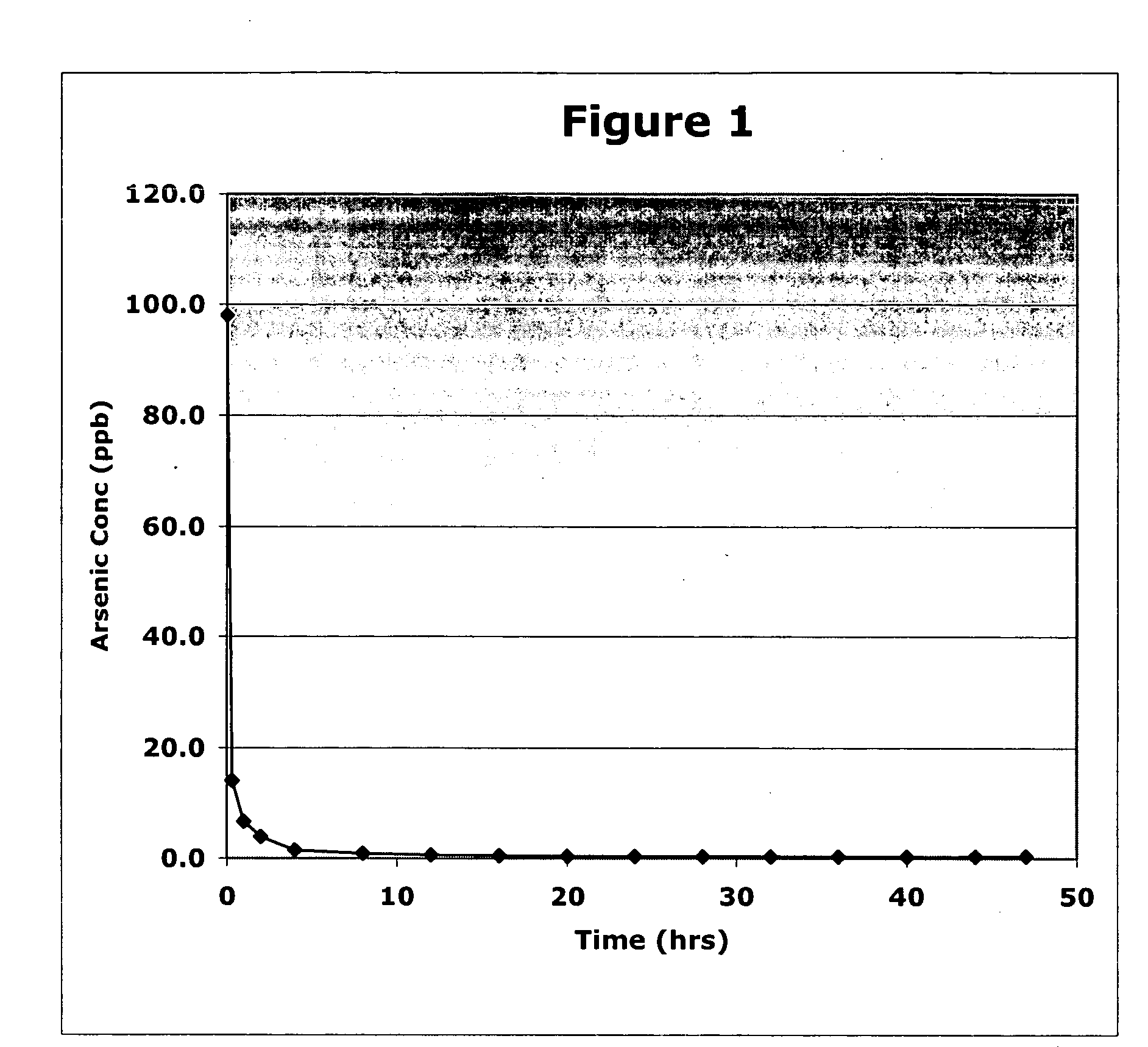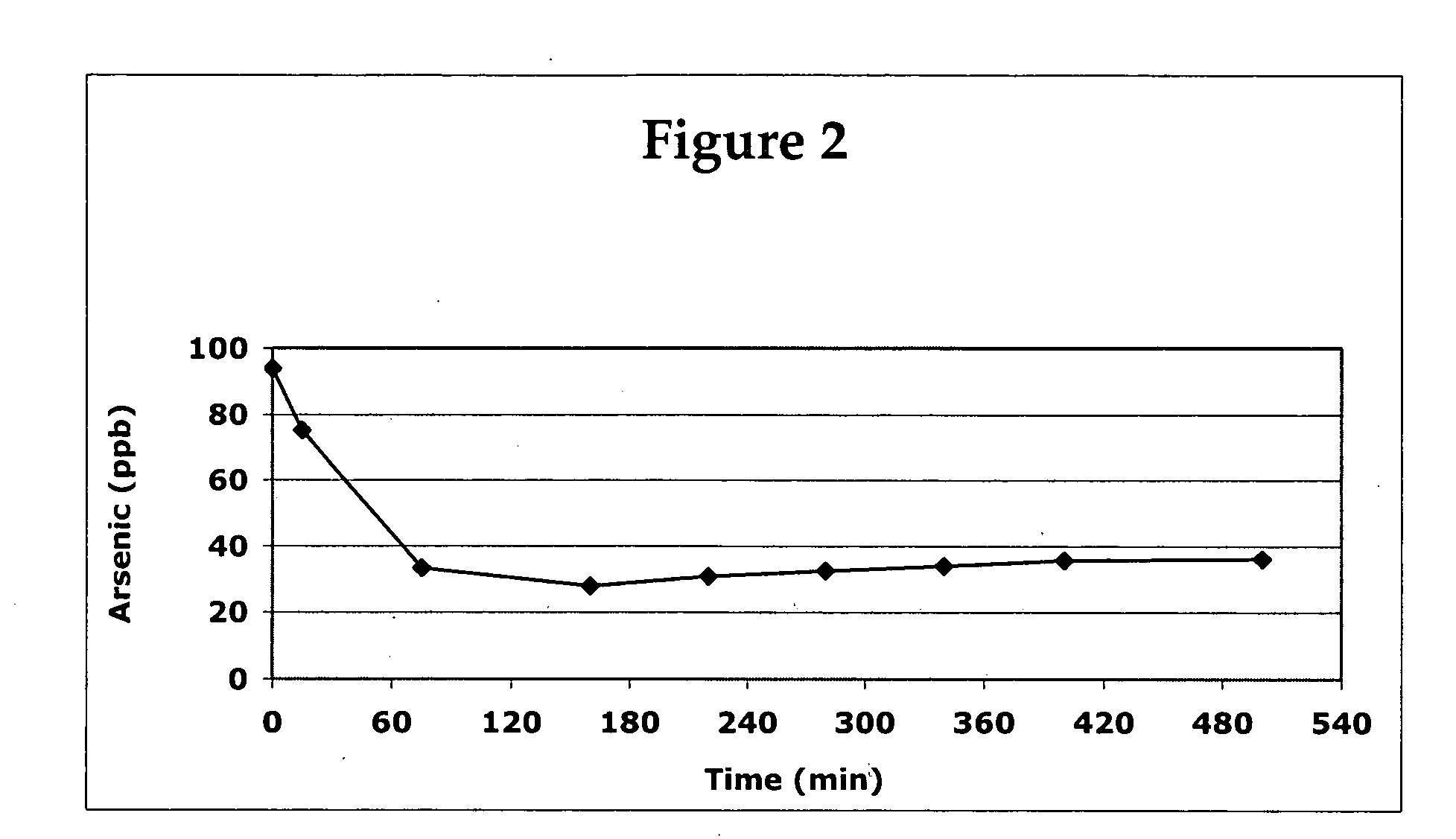Solid materials for removing arsenic and method thereof
a technology of solid materials and arsenic, which is applied in the direction of physical/chemical process catalysts, silicon compounds, other chemical processes, etc., can solve the problems of not readily available cost-effective remedies for arsenic removal from ground water and surface waters, contaminated drinking water sources, and ineffective removal of certain metals
- Summary
- Abstract
- Description
- Claims
- Application Information
AI Technical Summary
Benefits of technology
Problems solved by technology
Method used
Image
Examples
example 1
Four Solutions were Prepared
[0018]Solution (A) was prepared by dissolving 7.5 g of manganese (III) 2,4 pentanedionate (Mn(C5H7O2)3 and 7.5 g ferric chloride (FeCl3) in 200 g methanol and adding 100 g of GAC. The combined material (solution and solid) was evacuated to remove air from the GAC, then placed in a vacuum oven (pressure of 26 to 28 inches of water) and dried at 150° C. for 16 hours.
[0019]Solution (B) was prepared by dissolving 1 g of manganese (III) 2,3 pentanedionate and 1.5 g ferric chloride (FeCl3) in 15 g of methanol.
[0020]Solution (C) was prepared by stirring 14.7 g (CH3O)4Si and 3.14 g (CH3O)3SiCH2CH2CF3 with 18 g of methanol. Solution (D) was prepared by mixing and stirring 10 g water with 21 g methanol and 0.01 g of ammonium hydroxide.
[0021]Solution (D) was added to Solution (C) with stirring. Solution (B) was then added to the (D) / (C) mixture and added to 47.2 g of Solution (A) and evacuated to remove any remaining air from the GAC and to allow the sufficient inte...
example 2
Four Solutions were Prepared
[0023]Solution (A) was prepared by dissolving 5.0 g of manganese (III) 2,4 pentanedionate (Mn(C5H7O2)3 and 5.0 g ferric chloride (FeCl3) in 200 g methanol and adding 100 g of GAC. The combined material (solution and solid) was evacuated to remove air from the GAC, then placed in a vacuum oven (pressure of 26 to 28 inches of water) and dried at 150° C. for 16 hours.
[0024]Solution (B) was prepared by dissolving 1 g of manganese (III) 2,3 pentanedionate and 1 g ferric chloride (FeCl3) in 15 g of methanol.
[0025]Solution (C) was prepared by stirring 14.7 g (CH3O)4Si and 3.14 g (CH3O)3SiCH2CH2CF3 with 18 g of methanol.
[0026]Solution (D) was prepared by mixing and stirring 10 g water with 21 g methanol and 0.01 g of ammonium hydroxide
[0027]Solution (D) was added to Solution (C) with stirring. Solution (B) was then added to the (D) / (C) mixture and added to 47.2 g of Solution (A) and evacuated to remove any remaining air from the GAC and to allow the sufficient in...
PUM
| Property | Measurement | Unit |
|---|---|---|
| pH | aaaaa | aaaaa |
| hydrophobic | aaaaa | aaaaa |
| concentration | aaaaa | aaaaa |
Abstract
Description
Claims
Application Information
 Login to View More
Login to View More - R&D Engineer
- R&D Manager
- IP Professional
- Industry Leading Data Capabilities
- Powerful AI technology
- Patent DNA Extraction
Browse by: Latest US Patents, China's latest patents, Technical Efficacy Thesaurus, Application Domain, Technology Topic, Popular Technical Reports.
© 2024 PatSnap. All rights reserved.Legal|Privacy policy|Modern Slavery Act Transparency Statement|Sitemap|About US| Contact US: help@patsnap.com









